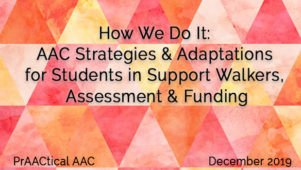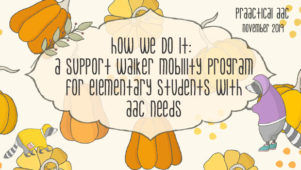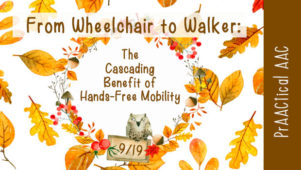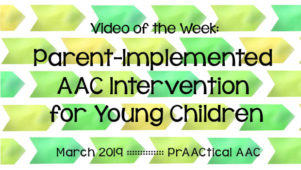From Wheelchair to Hands-free Walker for Preschool Children with AAC Needs

 We are excited to share the second post in Christine Wright-Ott’s series on promoting hands-free independent mobility in young AAC learners. Christine is an Occupational Therapist and consultant at The Bridge School in Hillsborough California. She authored the chapter “Mobility” in the 4-7th editions of the book, Occupational Therapy for Children. She lectures at universities and conferences including ATIA, Closing the Gap, ISAAC, ISS, and AAC by the Bay.
We are excited to share the second post in Christine Wright-Ott’s series on promoting hands-free independent mobility in young AAC learners. Christine is an Occupational Therapist and consultant at The Bridge School in Hillsborough California. She authored the chapter “Mobility” in the 4-7th editions of the book, Occupational Therapy for Children. She lectures at universities and conferences including ATIA, Closing the Gap, ISAAC, ISS, and AAC by the Bay.
Enjoy!
Support Walker Mobility at the Bridge School
I would like to share with you an innovative hands-free Support Walker Mobility Program developed at The Bridge School, which is a private school for preschool and elementary children with complex communication and physical disabilities located on the district’s public elementary school campus. It is dedicated to ensuring that students achieve full participation in their communities through the use of augmentative & alternative means of communication (AAC), mobility and assistive technology (AT) applications. The Bridge School team recognizes the developmental, social, visual, physical and educational benefits of embedding hands-free mobility into the curricula. Preschool and elementary students participate in self-initiated mobility experiences through the use of hands-free support walkers throughout the school day. Students primarily use the KidWalk support walker at the Bridge School, because it is designed with a large mid-wheel, making it more maneuverable on the school’s uneven playground and over the rubberized mats in the accessible play structure area. It is hands-free, has a small turning radius, provides dynamic vertical and lateral weight shift. The frame does not limit the student’s physical participation in playground activities with peers and students can reach the large wheel to assist in turning and maneuvering it.
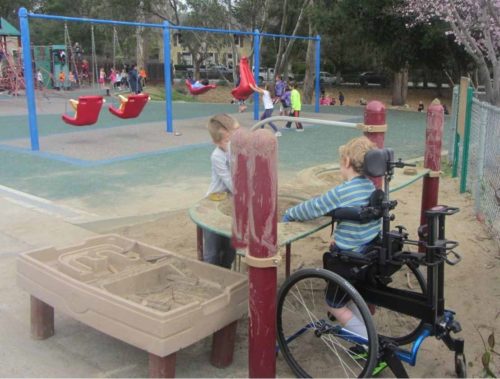
A student in his KidWalk meets a friend at the sandbox. The large mid-wheels provide maneuverability over the uneven playground surfaces.
Preschool Mobility Experiences & Observations
Preschool students transfer from their wheelchairs or strollers to a support walker to participate in language/music group, activity centers, outdoor time and field trips. Upright standing mobility enables them to experience the same activities as typically developing preschool children: pushing and carrying toys, opening doors, walking over to touch or hug a friend, walking into a playhouse or tent and carrying wood to the campfire during dramatic play. While using the walker, children can orient themselves to sounds and objects, paint with their feet, dance and imitate movements during music/language group, play hide and seek, run, jump, walk to the book shelf to choose a book, sneak up on a friend or push backwards to get away! The speech-language therapists are pleased that mobile preschool students demonstrate more attention, joint engagement and preferred activities, more gesturing, pointing, imitating and an increase in volume and frequency of verbalizations and vocalizations. The occupational therapists observe students in hands-free walkers reaching and touching above shoulder height, and students with cortical visual impairment (CVI) experience more visually directed reach. The students have more experiences to problem solve, discover and demonstrate their personalities. The KidWalk specifically provides some students with the opportunity to experience sensory motor activities not available when sitting: vestibular (spinning), proprioceptive (jumping) and kinesthetic (reaching, bumping and touching), supporting self-regulation. Improved motor control in the trunk and upper extremities has also been observed.
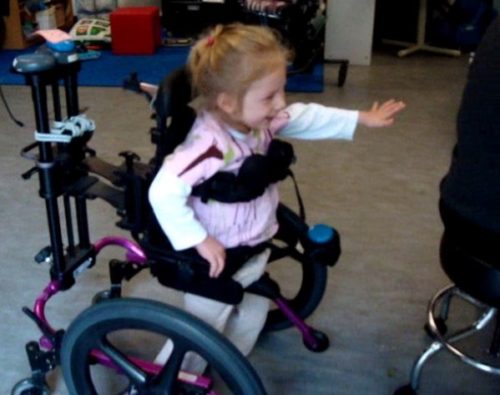
A preschooler in a KidWalk sneaks up to surprise her teacher. She is demonstrating joint engagement, planning, problem-solving, anticipation, and is reaching, giggling, and vocalizing.
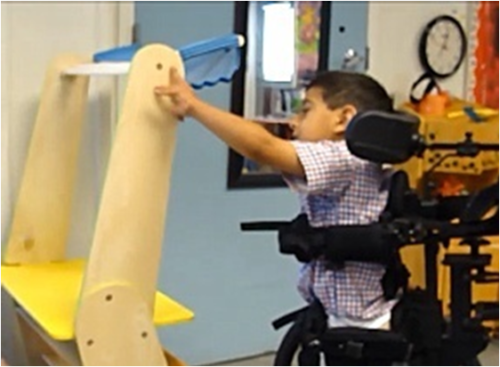
A preschooler explores and reaches above shoulder height.
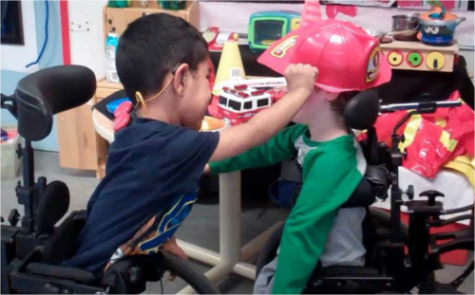
Two students engage in play while in their support walkers.
Summary
Walking is far more complicated and beneficial for a child’s development than moving from one location to another. Preschool students who experience hands-free mobility at the Bridge School are more engaged with objects and people, discover favorite activities and locations, move close to classroom activities and peers, reach and touch, play games with peers, push toys and participate in dramatic play. Post #3 will describe the support walker program for the elementary students, which includes inclusive physical education, mobility math and access to peers and activities at recess.
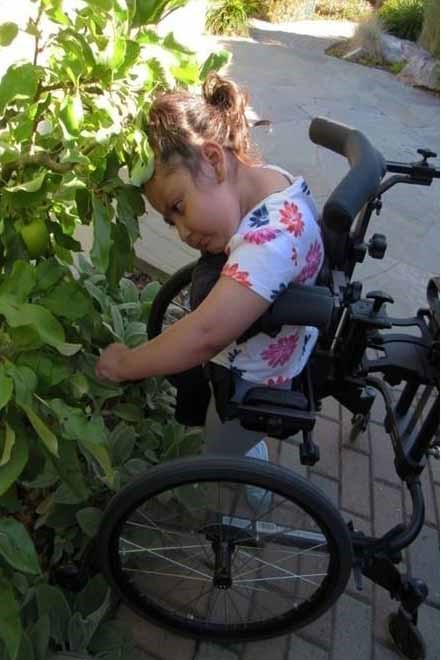
A preschool student with CVI moves in her and discovers a plant, which she reaches for visually focusing her hand on the leaf.
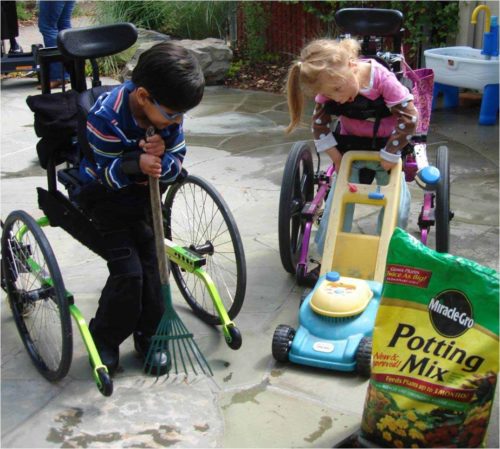
Preschoolers choose gardening tools in dramatic play.
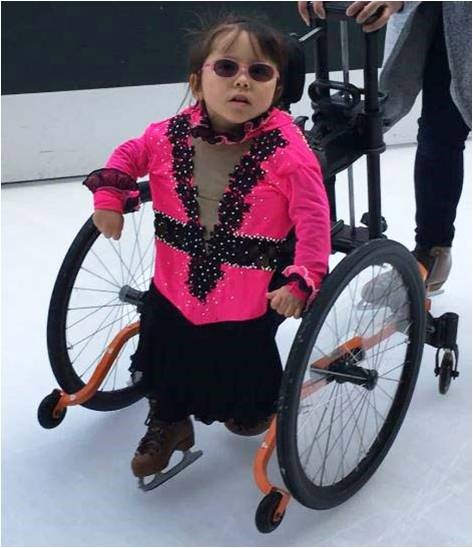
A preschool student chose this pink sparkly dress to wear at the ice skating field trip and was able to move her legs to ice skate!
Post 2:
http://curriculum.bridgeschool.org/docs/mobility/mobility_matters.pdf
http://curriculum.bridgeschool.org/docs/mobility/kidwalk_article.pdf
http://www.icanwalk2.com/benefits.html
Filed under: Featured Posts, PrAACtical Thinking
Tagged With: mobility, mobility impairment, physical disability, young children
This post was written by Carole Zangari

